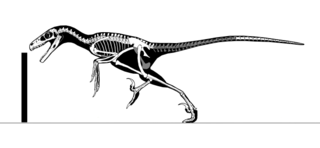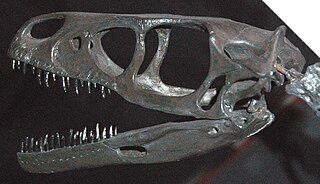
Saurornitholestes is a genus of carnivorous dromaeosaurid theropod dinosaur from the late Cretaceous of Canada (Alberta) and the United States.

Atrociraptor is a genus of saurornitholestine dromaeosaurid theropod dinosaur from the Late Cretaceous of Alberta, Canada.

Avimimus, meaning "bird mimic", is a genus of oviraptorosaurian theropod dinosaur, named for its bird-like characteristics, that lived in the late Cretaceous in what is now Mongolia, around 85 to 70 million years ago.

Adasaurus is a genus of dromaeosaurid dinosaur that lived in Asia during the Late Cretaceous period about 70 million years ago. The genus is known from two partial specimens found in the Nemegt Formation of Mongolia that were partially described in 1983 by the paleontologist Rinchen Barsbold.

Achillobator is a genus of large dromaeosaurid theropod dinosaur that lived during the Late Cretaceous period about 96 million to 89 million years ago in what is now the Bayan Shireh Formation of Mongolia. The genus is currently monotypic, only including the type species A. giganticus. The first remains were found in 1989 during a Mongolian-Russian field expedition and later described in 1999. Remains at the type locality of Achillobator may represent additional specimens. It represents the first and largest dromaeosaurid known from the Bayan Shireh Formation.

Caenagnathasia is a small caenagnathid oviraptorosaurian theropod from the Late Cretaceous of Uzbekistan.

Bagaceratops is a genus of small protoceratopsid dinosaurs that lived in Asia during the Late Cretaceous, around 72 to 71 million years ago. Bagaceratops remains have been reported from the Barun Goyot Formation and Bayan Mandahu Formation. One specimen may argue the possible presence of Bagaceratops in the Djadochta Formation.

The Bayan Shireh Formation is a geological formation in Mongolia, that dates to the Cretaceous period. It was first described and established by Vasiliev et al. 1959.
Bissektipelta is a genus of ankylosaurine thyreophoran dinosaurs that lived in Asia during the Late Cretaceous in what is now the Bissekty Formation of Uzbekistan. Bissektipelta is a monospecific genus, containing only the type species B. archibaldi.

Hulsanpes is a genus of halszkaraptorine theropod dinosaurs that lived during the Late Cretaceous in what is now the Barun Goyot Formation of Mongolia, about 75-72 million years ago. The remains were found in 1970 and formally described in 1982 by Halszka Osmólska, who noted that the genus is represented by an immature individual. Hulsanpes represents the first record of the basal dromaeosaurid subfamily Halszkaraptorinae.

Velociraptorinae is a subfamily of the theropod group Dromaeosauridae. The earliest velociraptorines are probably Nuthetes from the United Kingdom, and possibly Deinonychus from North America. However, several indeterminate velociraptorines have also been discovered, dating to the Kimmeridgian stage, in the Late Jurassic Period. These fossils were discovered in the Langenberg quarry, Oker near Goslar, Germany.

Austroraptor is a genus of dromaeosaurid theropod dinosaur that lived during the Campanian and Maastrichtian ages of the Late Cretaceous period in what is now Argentina.

Hesperonychus was a small, carnivorous dinosaur. It was a member of the family Dromaeosauridae, along with its larger relatives Deinonychus and Velociraptor. There is one described species, Hesperonychus elizabethae. The type species was named in honor of Dr. Elizabeth Nicholls of the Royal Tyrrell Museum of Palaeontology who collected it as a student in 1982. It is known from fossils recovered from the lowermost strata of the Dinosaur Park Formation of Alberta, dating to the late Cretaceous about 76.5 million years ago. Though known from partial remains, researchers have estimated that it was a small dinosaur measuring about 1 metre (3.3 ft) long and weighing between 1.5 and 2 kilograms, making it the smallest carnivorous non-avian dinosaur known from North America.

Saurornitholestinae is a subfamily of the theropod group Dromaeosauridae. The saurornitholestines currently include three monotypic genera: Atrociraptor marshalli, Bambiraptor feinbergi, and Saurornitholestes langstoni. All are medium-sized dromaeosaurs from the Late Cretaceous of western North America. The group was originally recognized by Longrich and Currie as the sister taxon to a clade formed by the Dromaeosaurinae and Velociraptorinae. However, not all phylogenetic analyses recover this group and/or with the same proposed genera.
The Bissekty Formation is a geologic formation and Lagerstätte which crops out in the Kyzyl Kum desert of Uzbekistan, and dates to the Late Cretaceous Period. Laid down in the mid to late Turonian, it is dated to about 92 to 90 Ma.

Acheroraptor is an extinct genus of dromaeosaurid theropod dinosaur known from the latest Maastrichtian Hell Creek Formation of Montana, United States. It contains a single species, Acheroraptor temertyorum. A. temertyorum is one of the two geologically youngest known species of dromaeosaurids, the other being Dakotaraptor, which is also known from Hell Creek. A basal cousin of Velociraptor, Acheroraptor is known from upper and lower jaw material.

This timeline of dromaeosaurid research is a chronological listing of events in the history of paleontology focused on the dromaeosaurids, a group of sickle-clawed, bird-like theropod dinosaurs including animals like Velociraptor. Since the Native Americans of Montana used the sediments of the Cloverly Formation to produce pigments, they may have encountered remains of the dromaeosaurid Deinonychus hundreds of years before these fossils came to the attention of formally trained scientists.

Timurlengia is an extinct genus of tyrannosauroid theropod dinosaur found in Uzbekistan, in the Bissekty Formation in the Kyzylkum Desert, hailing from the Turonian age of the early Late Cretaceous. The type species is Timurlengia euotica.

Ulughbegsaurus is a dubious genus of theropod dinosaur from the Late Cretaceous aged Bissekty Formation, Uzbekistan. The type species is Ulughbegsaurus uzbekistanensis.
Dzharaonyx is a genus of alvarezsaurid theropod dinosaur from the Late Cretaceous Bissekty Formation of Uzbekistan. The type species is Dzharaonyx eski; eski being an Uzbek word for "old".




















